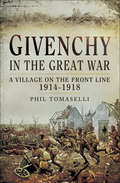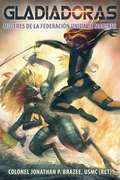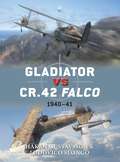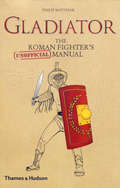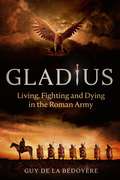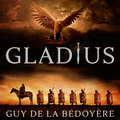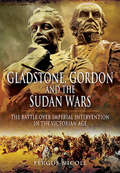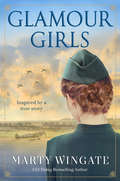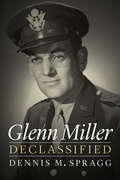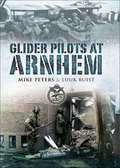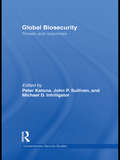- Table View
- List View
Given Up for Dead: America's Heroic Stand at Wake Island
by Bill SloanA gripping narrative of unprecedented valor and personal courage, here is the story of the first American battle of World War II: the battle for Wake Island. Based on firsthand accounts from long-lost survivors who have emerged to tell about it, this stirring tale of the "Alamo of the Pacific" will reverberate for generations to come. On December 8, 1941, just five hours after the bombing of Pearl Harbor, Japanese planes attacked a remote U. S. outpost in the westernmost reaches of the Pacific. It was the beginning of an incredible sixteen-day fight for Wake Island, a tiny but strategically valuable dot in the ocean. Unprepared for the stunning assault, the small battalion was dangerously outnumbered and outgunned. But they compensated with a surplus of bravery and perseverance, waging an extraordinary battle against all odds. When it was over, a few hundred American Marines, sailors, and soldiers, along with a small army of heroic civilian laborers, had repulsed enemy forces several thousand strong--but it was still not enough. Among the Marines was twenty-year-old PFC Wiley Sloman. By Christmas Day, he lay semiconscious in the sand, struck by enemy fire. Another day would pass before he was found--stripped of his rifle and his uniform. Shocked to realize he hadn't awakened to victory, Sloman wondered: Had he been given up for dead--and had the Marines simply given up? In this riveting account, veteran journalist Bill Sloan re-creates this history-making battle, the crushing surrender, and the stories of the uncommonly gutsy men who fought it. From the civilians who served as gunmen, medics, and even preachers, to the daily grind of life on an isolated island--literally at the ends of the earth--to the agony of POW camps, here we meet our heroes and confront the enemy face-to-face, bayonet to bayonet.
Given Up for Dead: American GI's in the Nazi Concentration Camp at Bergda
by Flint WhitlockDuring World War II, prisoners of war were required by the Geneva Conventions to be treated according to established rules. But in late 1944, when a large number of Americans were captured or surrendered during the Battle of the Bulge and elsewhere, their captors had different plans. Those who were Jewish or from some other "undesirable" ethnic or religious group were separated from their fellow captives and sent to the brutal slave-labor camp at Berga. Until now, the story of what these men endured has been a well-guarded secret.
Givenchy in the Great War: A Village on the Front Line, 1914–1918
by Phil TomaselliThe village of Givenchy-ls-la-Basse sits on a small rise in the Pas de Calais Department in northern France. One hundred years ago it was overtaken by the First World War. The fighting there was intense eleven Victoria Crosses were won in this tiny locality between 1914 and 1918. Phil Tomasellis in-depth account shows what happened at Givenchy when it became a battlefield, and the story here was repeated in the other villages and towns on the Western Front. Givenchys key position made it the target for crushing bombardments, infantry assaults and subterranean warfare. The landscape was pulverized by shellfire, the ground beneath was honeycombed with tunnels. Mining operations, shelling, sniping and trench raids took place around the remains of the village even when this stretch of the front line was relatively quiet. The grueling struggle of attrition that characterized the fighting on the Western Front continued here throughout the war. Phil Tomasellis gripping narrative makes extensive use of war diary extracts, personal stories, official and unofficial histories.
Giving Full Measure to Countermeasures: Addressing Problems in the DoD Program to Develop Medical Countermeasures Against Biological Warfare Agents
by Acquisition of Medical Countermeasures Against Biological Warfare AgentsIn recent years, substantial efforts have been initiated to develop new drugs, vaccines, and other medical interventions against biological agents that could be used in bioterrorist attacks against civilian populations. According to a new congressionally mandated report from the Institute of Medicine and National Research Council of the National Academies, to successfully develop these drugs, vaccines, and other medical interventions against biowarfare agents, Congress should authorize the creation of a new agency within the Office of the Secretary of the U.S. Department of Defense. The committee recommended that Congress should improve liability protections for those who develop and manufacture these products, to stimulate willingness to invest in new research and development for biowarfare protection. Giving Full Measure to Countermeasures also identifies other challenges—such as the need for appropriate animal models and laboratories equipped with high-level biosafety protections—that will require attention if DoD efforts to develop new medical countermeasures are to be successful.
Gladiadoras, Mujeres de la Federación Unida de Marines
by Jonathan P. Brazee Diego PradoLa Cabo Segundo Tamara Veal del Cuerpo de Marines de la Federación Unida llama la atención de los reclutadores que la nominan para servir como Especialista en Combate Mano a Mano. Las gladiadoras, como mejor se las conoce, son las campeonas genéticamente modificadas de la humanidad que enfrentan a las reinas d’relle de los Klethos en el ring de combate cuando los Klethos publican un desafío por un mundo humano. Si triunfa, el planeta se queda en posesión de la humanidad; si pierde, no sólo pierden sus vidas, pero el mundo también. Con los Klethos mucho más avanzados y poderosos militarmente, capaces de derrotar a la humanidad en una guerra total, el ring de desafío es la única manera de retener al menos algunos mundos para el hombre. Mientras la vida como gladiadora está llena del estatus de celebridad y la gratitud de la humanidad, viene con un pesado precio. No sólo existe el riesgo verdadero de la muerte en el anillo, si un gladiador sobrevive a esto, el “Cráter” o Cáncer de Regeneración Acelerada tomará su vida en pocos años. La Cabo Segundo Tamara Veal, quien ha encontrado un hogar en los Marines, tiene que decidir si aceptará la nominación. Tendría que abandonar a sus hermanos y hermanas en el Cuerpo, ingresar al curso de gladiador y someterse a la modificación genética extrema que la dejará casi irreconocible de la mujer que antes era. Hacerse gladiadora le permitirá servir a la humanidad mucho mejor que todo lo que podría hacer como un Marine, pero a un costo personal enorme.
Gladiator vs CR.42 Falco
by Hakan GustavssonBritish and Italian biplanes clashed over the Mediterranean at Crete and Malta, and in East and North Africa early in World War II. Both the Gloster Gladiator and the Fiat CR.42 Falco represented the peak in the development of the biplane fighter, which could trace its lineage back to World War I. However, by the time both aircraft entered service in the late 1930s, they were already obsolete. Nevertheless, they gave sterling service on all fronts in the Mediterranean and Africa in 1940-41. Indeed, the CR.42 was the Regia Aeronautica's staple fighter in both North and East Africa, Greece and over Malta in 1940-41, during which time its pilots routinely fought British and Commonwealth squadrons equipped in the main with Gladiator biplanes. Some bitter dogfights were fought between these two types as the Allies attempted to gain control of the skies over North Africa, Greece and East Africa. Both types were flown in the main by highly experienced pre-war pilots, and this in turn made for some closely fought engagements. The first known combat between the CR.42 and the Gladiator took place on 14 June 1940 over North Africa and the last engagement between the two types occurred on 24 October 1941 over the East African front.
Gladiator: The Roman Fighter's [Unofficial] Manual
by Philip MatyszakAn entertaining yet factual insider's guide: how to become a gladiator, hone your fighting skills, and thrill the crowds in the Colosseum. So you think you'd like to be a gladiator? Find out how to get thousands to idolize you as the strongest, meanest fighter in the Roman empire. Win fame and fortune in one of Rome's most glamorous locations, in the presence of the emperor himself. Who wouldn't kill for a job like that? This handy guide tells you everything you need to know before you step out to fight for your life in front of a roaring crowd: Why you should become a gladiator How to join the most glamorous--yet lethal--profession on earth Who will try to kill you, and with what Which arena of the empire is the right one for you When and how often you will fight What happens before, during, and after a duel Combining the latest research with modern reconstructions, Gladiator helps you experience firsthand the spectacular yet brutal life and death of the most iconic figure of ancient Rome.
Gladiators: Deadly Arena Sports of Ancient Rome
by Christopher EpplettA history of gladiators-with an added bite!It’s hard for modern readers to truly grasp the spectacle that was arena sports in ancient Rome, which pitted man against man and man against beast in mortal combat. Our modern games of football and hockey, or even boxing and MMA, truly pale in comparison. The Gladiators is a comprehensive survey of these ancient sports, focusing on gladiatorial combat and the beast hunts (venationes). While many books have been written on arena spectacles in ancient Rome, they generally neglect the venationes, despite the fact that the beast hunts, of various dangerous wild animals (including lions, tigers, elephants, and rhinos), were almost as popular as gladiatorial spectacles and endured over a longer period of time. Dr. Christopher Epplett gives a full and detailed treatment of both types of spectacle.The author starts by explaining the origins of these bloody combat sports in the late Roman Republic before surveying the growth of these events during the first two centuries of the Empire, when emperors possessed the resources to stage arena spectacles on an unmatched scale. The details of the training, equipment, and fighting styles used by different types of combatants are covered, as are the infrastructure of the arenas and behind-the-scenes organization that was essential to the successful staging of arena events. Particular attention is paid to the procurement of the countless wild animals necessary to stage venationes throughout the Empire. A gladiator book with added bite, The Gladiators is sure to be welcomed by scholars and general readers alike.Skyhorse Publishing, as well as our Arcade imprint, are proud to publish a broad range of books for readers interested in history--books about World War II, the Third Reich, Hitler and his henchmen, the JFK assassination, conspiracies, the American Civil War, the American Revolution, gladiators, Vikings, ancient Rome, medieval times, the old West, and much more. While not every title we publish becomes a New York Times bestseller or a national bestseller, we are committed to books on subjects that are sometimes overlooked and to authors whose work might not otherwise find a home.
Gladius: Living, Fighting and Dying in the Roman Army
by Guy de BédoyèreThe Roman army was the greatest fighting machine the ancient world produced. The Roman Empire depended on soldiers not just to win its wars, defend its frontiers and control the seas but also to act as the engine of the state. Roman legionaries and auxiliaries came from across the Roman world and beyond. They served as tax collectors, policemen, surveyors, civil engineers and, if they survived, in retirement as civic worthies, craftsmen and politicians. Some even rose to become emperors. Gladius takes the reader right into the heart of what it meant to be a part of the Roman army through the words of Roman historians, and those of the men themselves through their religious dedications, tombstones, and even private letters and graffiti. Guy de la Bédoyère throws open a window on how the men, their wives and their children lived, from bleak frontier garrisons to guarding the emperor in Rome, enjoying a ringside seat to history fighting the emperors' wars, mutinying over pay, marching in triumphs, throwing their weight around in city streets, and enjoying esteem in honorable retirement.
Gladius: Living, Fighting and Dying in the Roman Army
by Guy de BédoyèreThe Roman army was the greatest fighting machine the ancient world produced. The Roman Empire depended on soldiers not just to win its wars, defend its frontiers and control the seas but also to act as the engine of the state. Roman legionaries and auxiliaries came from across the Roman world and beyond. They served as tax collectors, policemen, surveyors, civil engineers and, if they survived, in retirement as civic worthies, craftsmen and politicians. Some even rose to become emperors. Gladius takes the reader right into the heart of what it meant to be a part of the Roman army through the words of Roman historians, and those of the men themselves through their religious dedications, tombstones, and even private letters and graffiti. Guy de la Bédoyère throws open a window on how the men, their wives and their children lived, from bleak frontier garrisons to guarding the emperor in Rome, enjoying a ringside seat to history fighting the emperors' wars, mutinying over pay, marching in triumphs, throwing their weight around in city streets, and enjoying esteem in honorable retirement.
Gladius: The World of the Roman Soldier
by Guy de la BédoyèreThis &“encyclopedic [volume] collects pretty much every fact known about what it was like to be in the military arm of the Roman Empire" (The New York Times Book Review). The Roman army was the greatest fighting machine in the ancient world. It was also the single largest organization in Western antiquity, taking in members from all classes, from senators to freed slaves. The Roman Empire depended on its army not just to win wars, defend its frontiers, and control the seas, but to act as the very engine of the state. In Gladius—the Latin word for sword—Guy De la Bédoyère reveals what it meant to be a soldier in the army that made the empire. Surveying numerous aspects of Roman military life between 264 BCE and 337 CE, De la Bédoyère draws not only on the words of famed Roman historians, but also those of the soldiers themselves, as recorded in their religious dedications, tombstones, and even private letters and graffiti. He vividly recreates their everyday lives, whether in a bleak frontier garrison in Britain or North Africa, guarding the emperor in Rome, fighting on foreign battlefields, mutinying over pay, marching in triumph, throwing their weight around on city streets, or enjoying honorable retirement. By illuminating the history of one organization that reflected all corners of the Roman world, Gladius gives us a portrait of an ancient society that is unprecedented in both its broad sweep and gritty intimacy.
Gladstone, Gordon and the Sudan Wars: The Battle over Imperial Invention in the Victorian Age
by Fergus NicollGeneral Gordons death in Khartoum on 26 January 1885 and the fall of the besieged city to the forces of the Mahdi was a crucial episode in British imperial history. It was deeply controversial at the time, and it still is today. Gordon has routinely been depicted as the hero of the story, in contrast to Prime Minister Gladstone who is often portrayed as the villain of the piece, responsible for a policy of drift in Sudan.Fergus Nicolls radical reappraisal, which is based on eyewitness accounts and previously unpublished archive material, refutes the conventional image of both men. Presenting an inside view of Gladstones thinking and decision-making, Nicoll gives the prime minister credit for his steadfast insistence that Britain should have minimal engagement in and zero responsibility for Sudan. Gordon, who succumbed to a lasting mania that skewed his decision-making and undermined his military capacity, is cast in a more sceptical light. This fascinating insight into British policy in Africa exposes the inner workings of government, the influence of the press and public opinion and the power of a book to change a government.Each stage in the rapid sequence of events is reconsidered Gladstones steely determination to avoid involvement, Gordons partial evacuation of Khartoum, the siege, the despatch of the relief expedition that arrived too late, the abandonment of Sudan, and the subsequent political battle over responsibility. The personal cost to both men was great: Gordon lost his life and Gladstone saw his reputation gravely tarnished.
Glamour Girls: A Novel
by Marty WingateUSA Today bestselling author Marty Wingate's historical debut is "like reading a personal diary of the brave women who were unsung heroes of WWII," (Rhys Bowen, Royal Spyness mysteries) and will delight readers of Kelly Rimmer's The Things We Cannot Say and Noelle Salazar's The Flight Girls.During World War II, farmer's daughter Rosalie Wright becomes a pilot assisting the RAF. But will a romantic rivalry send her aerial dreams plummeting to earth?Ever since she was 10 years old, Rosalie Wright's eyes have been on the skies. But at the age of 18, on the verge of earning her pilot's license, the English farmer's daughter watches her dreams of becoming an aviatrix fly away without her. Britain's entry into World War II brings civilian aviation to a standstill. Then, Rosalie's father dies, leaving her, her mother, and her brothers to run the farm.Everything changes when she learns that the Air Transport Authority is recruiting women pilots to ferry warplanes across Britain to RAF bases. Despite her mother's objections, Rosalie cannot resist the call of her country--and the lure of the skies. During her training on Gipsy Moth aircraft, Rosalie forms a fast friendship with fellow flyer Caroline Andrews. Her trusty Ferry Pilots Notebook by her side, Rosalie delivers to five airfields in a day--while fighting an endless battle against skeptical male pilots and ground crews.She would much rather spend her time on the wing than on the arm of any man...until she meets gruff pilot Snug Durrant and RAF squadron leader Alan Chersey. Snug is a cynical, wisecracking playboy, and Alan is every WAAF's heartthrob...and Rosalie catches both their eyes. As the war drags on, and casualties mount, will love and tragedy send Rosalie's exhilarating airborne life crashing to the ground?
Glasgow at War, 1939–45 (Your Towns & Cities in World War Two)
by Craig ArmstrongAn in-depth look at how Scotland&’s largest city and its residents were affected by the Second World War, with photos included. Scotland was of grave strategic importance during World War II because of its geographical position, and Glasgow was the location of a significant number of important military and civil organizations as well as housing industry vital to the national war effort. As a result, Glasgow attracted enemy attention on many occasions—with the city and its hinterland being heavily raided by the Luftwaffe. These included the infamous raid on Clydebank in March 1941, which killed over five hundred civilians and left only seven houses undamaged in the town. Although Glasgow&’s shipyards, munitions factories, and other industries were all vital, so too was the location of the city itself. The River Clyde was the end point for many Atlantic convoys bringing precious food, material, and men to the war-struck British Isles, and the city was thus a vital link in the nation&’s war effort. No member of the population of Glasgow escaped the war. Huge numbers of men and women from the area came forward for service in the military or in roles involving the Home Guard, ARP services, nursing, and vital war industries. Residents struggled to maintain a household under strict rationing and the stresses of wartime life, and children were evacuated from the city to rural areas to escape the bombing campaigns. Glasgow was also home to a sizable Italian community, which was badly affected by internment and tight restrictions on movement and civil rights. The Italian community was also subjected to violent attacks when rioting mobs attacked Italian-owned business throughout the city. Glasgow at War 1939-1945 paints a portrait of a city fighting to survive, and poignantly commemorates the efforts and achievements of workers, fighters, and families divided.
Glasgow in the Great War
by Derek TaitWhen news of the war broke out in 1914, nothing could prepare the citizens of Glasgow for the changes that would envelop their city over the next four years. The story of Glasgow in the Great War is both an interesting and intriguing one. This book covers this historic citys involvement from the commencement of the Great War in July 1914, to the Armistice in November 1918, describing in great detail what happened to the city and its people, including their everyday lives, entertainment, spies and the internment of aliens living within the city.Glasgow played a key role in the deployment of troops to Northern Europe as well as supplying vital munitions. Local men responded keenly to recruitment drives and thousands of soldiers were billeted in the city before being sent off to fight the enemy overseas. The city also played a vital role in caring for the many wounded soldiers who returned home from the Front.The effect of the war on Glasgow was great. By the end of the conflict, there wasn't a family in Glasgow who hadn't lost a son, father, nephew, uncle or brother. There were tremendous celebrations in the streets as the end of the war was announced but the effects of the war lasted for years to come.Glasgow in the Great War features many forgotten news stories of the day and includes a considerable collection of rare photographs last seen in newspapers nearly 100 years ago.
Glass Voices: 10th Anniversary Edition
by Carol BruneauSurviving the 1917 Halifax Explosion leaves a grieving Nova Scotia couple on a long and difficult road to redemption in this &“textured and rich&” novel (Quill & Quire). Though they survived the Halifax Explosion of 1917, Lucy Caines and her wayward husband, Harry, lost everything in the day&’s terrible events—including their infant daughter. Determined to make peace with their grief and salvage what&’s left of their lives, they begin to rebuild on the rustic shores of Halifax&’s Northwest Arm. But coping isn&’t easy, and each descends into isolation and denial: Lucy through guilt and reticence, and Harry through drinking and gambling. Despite the birth of a treasured son, the couple faces a future clouded by fear and apprehension. Then, fifty-two years after the catastrophe, yet another calamity strikes. Now Lucy must confront the miracle of their survival, reexamine the past, and struggle to become the author of her own happiness.
Gleam and Glow
by Eve BuntingIt’s too dangerous to stay any longer--the war is coming closer. Viktor, little Marina, and Mama must pack what they can carry and flee their home. As they trudge beside the other refugees, Viktor worries about what lies ahead, and what he’s left behind--his room, his books, the fish Marina loves so much. Even worse, his papa is off fighting with the Liberation Army and doesn’t know they’ve left home. How will Papa ever find them now? Inspired by real events, master storyteller Eve Bunting recounts the harrowing yet hopeful story of a family, a war--and a dazzling discovery.
Glenn Miller Declassified
by Dennis M. SpraggOn December 15, 1944, Maj. Alton Glenn Miller, commanding officer of the Army Air Force Band (Special), boarded a plane in England bound for France with Lt. Col. Norman Francis Baessell. Somewhere over the English Channel the plane vanished. No trace of the aircraft or its occupants has ever been found. To this day Miller, Baessell, and the pilot, John Robert Stuart Morgan, are classified as missing in action. Weaving together cultural and military history, Glenn Miller Declassified tells the story of the musical legend Miller and his military career as commanding officer of the Army Air Force Band during World War II. After a brief assignment to the Army Specialist Corps, Miller was assigned to the Army Air Forces Training Command and soon thereafter to Supreme Headquarters, Allied Expeditionary Force, in the UK. Later that year Miller and his band were to be transferred to Paris to expand the Allied Expeditionary Forces Programme, but Miller never made it. Miller’s disappearance resulted in numerous conspiracy theories, especially since much of the information surrounding his military service had been classified, restricted, or, in some cases, lost. Dennis M. Spragg has gained unprecedented access to the Miller family archives as well as military and government documents to lay such theories to rest and to demonstrate the lasting legacy and importance of Miller’s life, career, and service to his country.
Glenview Naval Air Station (Images of America)
by Beverly Roberts DawsonIn 1923--just 20 years after the Wright brothers' first flight at Kitty Hawk--a Naval Reserve aviation training program was established at Great Lakes Naval Training Center. Originally, sea planes and a few small land-based planes were used for primary flight instruction. With the development of heavier, faster military aircraft, the Great Lakes facility became inadequate. Under Rear Adm. John Downes, commandant of the 9th Naval District, the search for a suitable new location was undertaken. Curtiss-Reynolds-Wright Airfield was deemed ideal for relocation of the aviation training program. From humble beginnings as Naval Reserve Aviation Base Chicago, Naval Air Station Glenview (the official U.S. Navy designation) went on to play a vital and unique role during World War II. Until closure in 1995, the base was home to thousands of Navy and Marine Reserve pilots, aircrews, and support personnel--proudly known as weekend warriors."
Glider Pilots at Arnhem
by Mike Peters Luuk BuistThe fierce struggle between the British 1st Airborne Division and the superior German forces in and around Arnhem is well documented. This book tells of the role played in the battle for Oosterbeek and the bridge at Arnhem itself by the men of the Glider Pilot Regiment (GPR). These men were already experienced soldiers who volunteered to join the airborne forces and take the fight to the Germans in a totally new regiment.The men of the GPR were predominantly SNCOs trained to fly wooden assault gliders into occupied territory. Once on the ground they were expected to go into battle with the troops they had delivered onto the Landing Zone. During the Arnhem operation they were involved in the initial defense of the LZs, before fighting house to house leading mixed groups of infantrymen, engineers and medics. In so doing they suffered extensive losses from which the Regiment never fully recovered. This book tells their story in their own words from the moment they landed on Dutch soil through the fierce fighting all around the ever shrinking perimeter until the survivors of the GPR proudly marked the route out for the battered survivors of 1st Airborne Division as they escaped over the Rhine.
Glider Pilots in Sicily
by Mike PetersThe British Airborne landings on Sicily are the least known and, without doubt, the most fraught with political and technical strife. Newly formed Air landing troops were delivered into battle in gliders they knew little about. The men of the Glider Pilot Regiment (GPR) had self-assembled the gliders while living in the empty packing cases. They accomplished this complex and technically challenged task while living on fly ridden, dusty North African airfields. After only a few hours of conversion training they took off for a night flight across the Mediterranean Sea that was to end in near-catastrophe.With over three hundred soldiers drowned off Sicily that night in July 1943, the first major operation attempted by the British using gliders almost ended in total disaster. In fact a few Airborne troops reached dry land and attacked their objectives. Shining examples of collective and individual acts of courage rocked the Italian and German defenders. This book tells the controversial story of that first mass glider operation and the men who proved the GPR motto Nothing is Impossible.This is the first account of the Sicily air landing operation.
Gliders of World War II: ‘The Bastards No One Wanted’
by Major Michael H. ManionThis study examines the role of combat gliders in Germany, the United Kingdom, and the United States during World War II (WWII). This thesis compares and contrasts each country with respect to pre-WWII glider experience, glider and airborne doctrine, glider pilot training, and glider production while outlining each country's major glider operations. The author then compares the glider operations in the China-Burma-India Theater to the operations in Europe to describe the unique challenges based on the terrain and mission. Next, this thesis presents an analysis of the glider's precipitous decline following WWII. The study concludes with recommendations for glider operations in the future based on the experiences of the past.
Glimmers of Change (The Bregdan Chronicles Ser. #7)
by Ginny DyeGlimmers of Change continues the sweeping historical saga that encompasses the first full year of the American Reconstruction. However, has the Civil War really ended? As far as the characters are concerned, Carrie and Janie are living their dream in Philadelphia, but what price will they pay when cholera sweeps through America once again? Robert searches for peace on the plantation, but forces are in place that are determined to deny it. Moses and Rose are driven by forces beyond their control to become leaders in the midst of a violent racial revolution. Jeremy discovers love, but will the reality of his heritage make it impossible, and will he survive the forces determined to destroy the factory? Finally, will Matthew free his heart and find love?
Global Biosecurity: Threats and Responses (Contemporary Security Studies)
by Peter KatonaThis book explores a range of biohealth and biosecurity threats, places them in context, and offers responses and solutions from global and local, networked and pyramidal, as well as specialized and interdisciplinary perspectives. Specifically covering bioterrorism, emerging infectious diseases, pandemic disease preparedness and remediation, agroterroism, food safety, and environmental issues, the contributors demonstrate that to counter terrorism of any kind, a global, networked, and multidisciplinary approach is essential. To be successful in biosecurity, this book argues it is necessary to extend partnerships, cooperation, and co-ordination between public health, clinical medicine, private business, law enforcement and other agencies locally, nationally and internationally. Internationally, a clear understanding is needed of what has happened in past epidemics and what was accomplished in past bioprograms (in Britain, South Africa, Russia, for example). This book also assesses how, with the right technology and motivation, both a state and a non-state actor could initiate an extremely credible biothreat to security at both local and national levels. This book will be of much interest to students, researchers and practitioners of security studies, public health, public policy and IR in general. Peter Katona is Associate Professor of Clinical Medicine at the David Geffen School of Medicine at UCLA in Infectious Diseases. He is co-founder of Biological Threat Mitigation, a bioterror consulting firm. John P. Sullivan is a lieutenant with the Los Angeles Sheriff’s Department. He is also a researcher focusing on terrorism, conflict disaster, intelligence studies, and urban operations. He is co-founder of the Los Angeles Terrorism Early Warning (TEW) Group. Michael D. Intriligator is Professor of Economics at the University of California, Los Angeles (UCLA). He is also Professor of Political Science, Professor of Public Policy in the School of Public Policy and Social Research, and Co-Director of the Jacob Marschak Interdisciplinary Colloquium on Mathematics in the Behavioral Sciences, all at UCLA.
Global Burden of Armed Violence 2015
by GenevaThe 2015 edition of the Global Burden of Armed Violence provides a wealth of data relevant to security and the post-2015 sustainable development framework. It estimates that 508,000 people died violently - in both conflict and non-conflict settings - every year in 2007–12, down from 526,000 in 2004–09. This trend is visible in non-conflict settings, where the proportion of women and girls is also slightly reduced, from 17 to 16 per cent. Yet, the number of direct conflict deaths is on the rise: from 55,000 to 70,000 per year over the same periods. Firearms are used in close to half of all homicides committed and in almost one-third of direct conflict deaths. Nearly USD 2 trillion in global homicide-related economic losses could have been saved if the homicide rate in 2000–10 had been reduced to the lowest practically attainable levels - between 2 and 3 deaths per 100,000 population.


